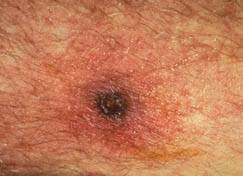 Scrub typhus or bush typhus is a form of typhus caused by the intracellular parasite Orientia tsutsugamushi.
Scrub typhus or bush typhus is a form of typhus caused by the intracellular parasite Orientia tsutsugamushi.
Orientia tsutsugamushi is a Gram-negative α-proteobacterium of family Rickettsiaceae.
It is similar in presentation to other forms of typhus, its pathogen is no longer included in genus Rickettsia with the typhus bacteria proper, but in Orientia.
The disease is thus frequently classified separately from the other typhi.
Signs and symptoms: fever, headache, muscle pain, cough, and gastrointestinal symptoms.
More virulent strains of O. tsutsugamushi can cause hemorrhaging and intravascular coagulation.
Morbilliform rash, eschar, splenomegaly, and lymphadenopathies are typical signs.
Leukopenia and abnormal liver function tests are commonly seen in the early phase of the illness.
Pneumonitis, encephalitis, and myocarditis occur in the late phase of illness.
Scrub typhus is transmitted by some species of trombiculid mites (“chiggers”, particularly Leptotrombidium deliense) which are found in areas of heavy scrub vegetation.
The mites feed on infected rodent hosts and subsequently transmit the parasite to other rodents and humans.
The bite of this mite leaves a characteristic black eschar that is useful for making the diagnosis.
Traditionally, it has been endemic in Asia, northern Australia.
1 billion people are estimated to be at risk in endemic lesions, with an estimated 1 million cases and 150,000 deaths annually.
It typically presents as an acute febrile illness that may be associated with headache, cough, shortness of breath, and altered, sensorium, and eschar at the site of the mite bite, and serves as a highly distinctive diagnostic clue.
Untreated the median case fatality is 6% but can reach 70% in severe disease.
Severe disease, including multi organ dysfunction and shock develops, approximately in 1/3 of hospitalized patients, and can lead to death in approximately 1/4 of cases despite treatment.
Scrub typhus is endemic to a part of the world known as the tsutsugamushi triangle (after O. tsutsugamushi).
This extends from northern Japan and far-eastern Russia in the north, to the territories around the Solomon Sea into northern Australia in the south, and to Pakistan and Afghanistan in the west.
It may also be endemic in parts of South America.
The precise incidence of the disease is unknown, as diagnostic facilities are not available in much of its large native range
The incidence in Japan has fallen over the past few decades
Diagnosis
In endemic areas, diagnosis is generally made on clinical grounds alone.
Clinical symptoms overlap with other infectious diseases such as dengue fever, paratyphoid, and pyrexia of unknown origin
The presence of an eschar can be, is quite diagnostic of scrub typhus, but this can be unreliable on dark skin.
The site of eschar which is usually where the mite bites is often located in covered areas.
A history of mite bite is often absent since the bite does not inflict pain and the mites are almost too small to be seen by the naked eye.
Usually, scrub typhus is often labelled as pyrexia of unknown origin in remote endemic areas, since blood culture is often negative.
It can be treated effectively with chloramphenicol.
The diagnosis may be confirmed by serology testing.
The Weil-Felix test, but this is notoriously unreliable.
The gold standard is indirect immunofluorescence, but the main limitation of this method is the availability of fluorescent microscopes, which are not often available in resource-poor settings where scrub typhus is endemic.
Indirect immunoperoxidase can be used with a light microscope, and the results of these tests are comparable to those from immunofluorescence assay.
Serological methods are most reliable when a four-fold rise in antibody titre is found.
In a nonendemic area, the diagnosis can be made from a single acute serum sample, but from endemic areas, this is not possible because antibodies may be found in up to 18% of healthy individuals.
Other diagnostic methods include culture and polymerase chain reaction, which are not routinely available, and the results do not always correlate with serological testing.
Cultures and polymerase chain reactions testing are affected by prior antibiotic treatment.
Treatment:
Scrub typhus has been treated with doxycycline, tetracycline or chloraphenicol, but azithromycin is increasingly used for mild scrub typhus.
Without treatment, scrub typhus is often fatal.
Since the use of antibiotics, case fatalities have decreased from 4–40% to less than 2%.
Strains that are resistant to doxycycline and chloramphenicol have been reported.
Rifampicin and azithromycin are alternatives.
Azithromycin is an alternative in children and pregnant women with scrub typhus, and when doxycycline resistance is suspected.
A randomized controlled study, showed the combination of intravenous doxycycline and azithromycin was a better therapeutic option for the treatment of severe scrub typhus, than monotherapy with either drug alone.
No vaccines are available.
Enormous antigenic variation in Orientia tsutsugamushi strains is recognized and hamper efforts to produce a viable vaccine.
